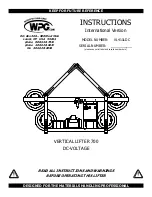
Rev 19.3/9-18
6
VL411LDC: #35162
ASSEMBLY
1) Open the shipping container and remove all materials for restraining or protecting the vacuum
lifter. Save the container for use whenever the lifter is transported.
2) Suspend the lifter from a crane as follows: Select hoisting equipment (crane and hoist, when
applicable) rated to carry the maximum load weight plus the lifter weight (see
SPECIFICATIONS: Maximum Load Capacity and Lifter Weight).
Note: Any application of the lifter must conform to all statutory or regulatory standards that
relate to the hoisting equipment when used in its geographical location (e.g., relevant OSHA
standards in the USA).
Tilt the lifter upwards until the pad frame is in a vertical orientation, resting on the integrated
parking feet. Make sure the lift slings are securely attached to the lifter. Then attach the
free eye of each lift sling onto the hoisting equipment hook.
WARNING: Hoisting equipment hook must be fitted with restraining latch to
prevent lift slings from slipping off under any circumstances.
Note: It may be desirable to use a large clevis to connect the lift slings to the hoisting
equipment hook. This makes suspending the lifter easier, since only the clevis must be
attached to or removed from the hoisting equipment hook.
WARNING: Clevis and clevis pin must be rated to carry maximum load weight
plus lifter weight.
Use the hoisting equipment to raise the lifter out of the shipping container. Be careful to
avoid damaging any vacuum pads. Remove the pad covers and save them for use whenever
the lifter is stored.
3) Connect the electrical connectors uniting the battery to the battery charger and the vacuum
generating system. The lifter is now operational.
4) Perform Operational and Load Tests for the lifter as directed in MAINTENANCE: T
ESTING
S
CHEDULE
.
Summary of Contents for VL411LDC
Page 2: ......
Page 30: ...Rev 19 3 9 18 28 VL411LDC 35162...
Page 31: ...Rev 19 3 9 18 29 VL411LDC 35162...
Page 32: ...Rev 19 3 9 18 30 VL411LDC 35162...









































